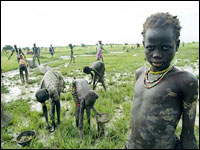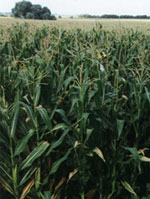
Gathering grain in Sudan.
In some ways the world food situation hasn’t changed for decades. There are still millions of starving people. There are still places where so much food is grown that it has to be thrown away. Fertilizers and pesticides pollute the countryside; soil erodes; groundwater tables drop. Every year when the new statistics come out, I flip through and think, “Ho hum.” It’s easy to become inured to tragedy if it goes on long enough on a big enough scale.
This year, though, I took time to read the fine print in the food and agriculture section of the Worldwatch Institute’s annual book Vital Signs. I found some surprises, which I will convey here in the form of a quiz, to see whether they are news to you, too.
1. The world’s top grain-producing nation is:
a. China
b. The United States
c. India
d. Russia
The answer is China by a long shot (1999 harvest 395 million tons). Next comes the U.S. (333 million tons), then India (185 million tons). Russia used to be a grain power; now its output is in free-fall, wheat harvest down by over 30 percent, corn harvest less than half of what it once was. When your economic system collapses, a lot goes down with it. And, as China demonstrates, the reverse is also true.
By the way, the numbers above demonstrate clearly that America does not “feed the world.” U.S. farmers grow about one-sixth of the world grain harvest, most of which we consume at home. We do have the world’s largest production excess; therefore we are the biggest grain exporter. Our exports — about 5 percent of world production — go primarily to feed animals in Europe and Japan.
2. The share of the world grain crop fed to animals is:
a. 70 percent
b. 55 percent
c. 37 percent
The answer is c. More than a third of the grain harvest is used for animal feed. Almost all the rice is eaten directly by people, but 70 percent of the corn and about half the wheat goes to pigs, chickens, and cows, in that order.
3. The crop that covers the largest area in the U.S. is:
a. Corn
b. Wheat
c. Soybeans

Oh, soy!
Soybeans, the fastest growing crop in the world. World production has increased nine-fold since 1950. Half of that is grown in the U.S. Brazil is the next largest producer, then Argentina, then China, where soybean cultivation originated. Only about a tenth of the soybeans grown are eaten directly by humans. The rest are crushed and pressed, yielding almost a third of the world’s cooking oil and more than half the oil-seed meal used in animal feed.
4. The amount of grain produced per person in the world is going:
a. Up
b. Down
If that question hadn’t had “per person” in it, the answer would have been “up.” But grain output per capita peaked in 1984 and has fallen by about 10 percent since. The world’s farmers are not keeping up with population growth. There seem to be three reasons for that: the collapse of Soviet production, the steady decline in African production, and the leveling off of yields in the highest-yielding places, such as Europe and the U.S.
5. The fastest-growing agricultural technology is:
a. Genetically modified crops
b. Organic farming
This is a trick question, because the answer just reversed itself. Last year it would have been genetically modified crops, which expanded in just four years from zero to almost 100 million acres (almost all in the U.S., Argentina, and Canada). Organic farming, after decades of persistent growth, is estimated to cover only 17 million acres worldwide.

GM crack corn, and we do care.
However, having run into market resistance and in some countries government regulation, farmers are reversing their headlong rush to biotech. The area planted in transgenic crops is 15 to 25 percent less this year than last. Organic area continues to grow by about 20 percent per year.
The use of genetically modified crops appears to have reduced slightly the use of insecticides on cotton and corn, but increased greatly the use of herbicides on soybeans. The growth of organic farming, of course, reduces the use of fertilizers and pesticides on everything.
Under its large, steady trends, world agriculture is changing. Depending on what you look at, you can perceive pending good news or impending disaster. The mighty can fall; the lowly can rise. The balance between food to eat and mouths to feed continues to be wildly different from place to place and very tenuous worldwide. Small surprises can turn into big ones.

